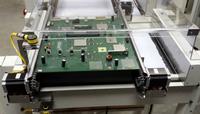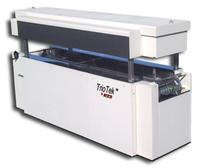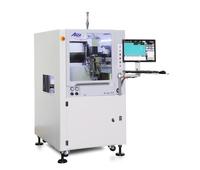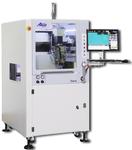ETS - Energy Technology Systems, Inc.

Manufacturer of Fluid Dispensing Equipment for Selective Conformal Coating, Potting, Encasulation & Underfill including Inspection, Conveying and Curing. Total Solution Fluid Dispensing & Conformal Cocating Process Lines.
ETS Energy Technology Systems, Inc. designs and manufactures factory automation equipment for the electronics assembly industry. From our inception in 1984, we have continuously advanced our core technologies of Thermal Systems, Conveying Systems, UV Curing Systems, Selective Conformal Coating, Fluid Dispensing Systems, and Inspection Systems. These core concepts and modules are quickly configured to meet our customers’ specific requirements. Whether a single system or hundreds, we create true products that are high quality, simple to manufacture, properly documented, support friendly, and easy to maintain. Ask us about your Fluid Dispensing, Selective Conformal Coating, Selective Soldering, Lead-Free Reflow, Curing, Drying, Pre-heat or Conveying Application. We’ve been bringing innovative solutions to these applications for over 30 years.
ETS - Energy Technology Systems, Inc. Postings
5 products »
Edge Grabber Inspection and PCB Conveyors
Modular Material PCB Handling Conveyors from ETS are ergonomic, customized to your exacting requirements and are easy to integrate into your printed circuit assembly systems. Solvent flash off conveyors, inspection stations, buffers, accumu...
TrioTek Model 2650 Curing Oven
TrioTek™ inline heat curing ovens from ETS are ideal for medium to high-volume curing, baking or drying of conductive inks, conformal coatings,adhesives, encapsulants and potting compounds. They are easy to integrate with automated sp...
The iCoat 6 accurately dispenses 100% solids, solvent-based and water-based coatings, such as urethanes, acrylics, adhesives, photoresists and solder masks with maximum accuracy and repeatability. Common conformal coating applications include:...
Designed for Conformal Coatings and other Curing applications. LEL Protection. High Solvents, High Solids, Humidity Curing. High Volume Production. Large Area Filters. Reel to Reel Foil Drip liner and removable drip pans for easy maintenance. Conv...
70 inches (180cm) heated length 30 inches (79cm) cooling length 4 Preheat Zones 1 Reflow Zone 3 Cooling Zones. The Cureflow Series offers Near Equilibrium Heating, also known as "Long Nozzle Hot Gas Heating", a method wherein t...
9 technical articles »
SELECT CONFORMAL COAT FORMULATION FOR PCB ENVIRONMENT
Aug 20, 2015 | Wes Noble
Temperature and Humidity on Selective Conformal Coating It is well known that selective conformal coating on printed circuit board (PCB) assemblies provides unparallel protection for PCB’s. Nevertheless, concentrated conditions of humidity, water, and high temperatures can have negative effects on the conformal coating itself causing it to fail and become inapt for its intended purpose. Taking this into consideration, it is prudent to choose the right type of conformal coating that best suits the application and environmental conditions under which an assembly is likely to undergo in use. The proper conformal coating will significantly reduce the likelihood of failure/rejection, saving both valuable time and money for any manufacturing process....
NON-CONTACT FLUID DISPENSING WITH PS-8200 JETTING VALVE
Aug 18, 2015 | Brian Stumm
Jetting Valve Technology Superior to Needle Dispensing Compared to traditional needle dispensing technology, jetting valve technology is the most effective method for quick and accurate fluid dispensing. Injection technology has many advantages, it provides a combination of high-speed, high quality and low cost production for fluid dispensing processes. Instead of putting focus on getting the application done, jet dispense technology focuses on performance, providing applications like underfill, potting and encapsulation with more precision than ever before. Improved Fluid Dispensing Speed and Accuracy Non-contact jetting valves offer a significant advantage over traditional needle dispense valves. Jetting Valve Dispenser precision reaches to 200µm with dot diameter or line width as small as 250µm and volumetric dispensing down to .0036µl. Minimum space between lines is 180µm and maximum fluid dispense speed is 200 dots/second. The following video illustrates quick, accurate fluid dispensing for an LED packaging application....
CONFORMAL COATING FOR WATER RESISTANT CIRCUIT ASSEMBLIES
Aug 18, 2015 | Brian Stumm
Why Selectively Conformal Coat the Electronic Assembly? Printed circuit boards (PCBs) are employed in a variety of products and devices, and this means that it might be necessary for your PCBs to be moisture resistant. It is important to choose the right type of conformal coating so you need not worry about the durability of your product. Fortunately, there are several options available that can help, and you can even use selective conformal coating robots to provide proper application of the coating....
ULTRAVIOLET (UV) CURING TECHNOLOGY
Aug 18, 2015 | Wes Noble
What is UV Curing? “Ultraviolet (UV) light is an electromagnetic radiation with a wavelength from 400 nm to 100 nm, shorter than that of visible light but longer than X-rays.” (Source: Wikipedia). Ultraviolet or UV curing is used to create a photochemical reaction using high intensity Ultraviolet (UV) energy or “light” to quickly dry inks, adhesives or conformal coatings. Most materials cure with a UV wavelength around 350 ~ 400nm although some materials require UVC energy near 255nm. There are many advantages to using UV curing over other traditional methods of curing. Not only will it increase production speed, it assists in creating a better bond, and improves scratch and solvent resistance. When compared to other methods of curing, UV curing generates a more reliable cured product at a much higher rate of production in a considerably shorter period of time....
Jul 31, 2015 | Brian Stumm
Technology is in constant change and circuit assembly is no different. It is becoming more and more advanced as needs change and demands for more capabilities increase. In order to meet these demands, equipment manufacturers are integrating the latest innovations and tools to serve the industry. The need to better protect printed circuit assemblies from harsh environments using automated selective conformal coating is becoming a must. 5 axis fluid dispensing allows conformal coating to be applied to printed circuit assemblies like never before....
Thermal Curing of Conformal Coatings
Jul 27, 2015 | Wes Noble
When it comes to the application of conformal coating, curing the coating plays a key role in the circuit assembly and selective conformal coating process. Curing conformal coating occurs after the coating spray/dispense process is complete. The coating is considered “cured” when the conformal coating on the circuit assembly is sufficiently tack-free to be handled. Curing can sometimes be accomplished at room temperature but takes a considerable amount of time to dry. Accelerated conformal coating curing decreases this drying period, the cure process reaches either the tack-free or a fully dried state but not quite having fully cured properties. Accelerated curing techniques include one or a combination of heat, moisture, UV light, and chemical reaction curing. This article focuses primarily on thermal or heat curing....
Measuring Conformal Coating Thickness
Jul 21, 2015 | Roger Plough
Achieving an even coat at the right desired thickness is a major challenge when it comes to applying conformal coating to a Printed Circuit Board (PCB). Applying a coating too thin will ultimately render the electronic assembly vulnerable to potential environmental risks therefore defeating the purpose of the coating. Apply the coat too thick, and it could leave the electronic specific components non-functional therefore destroying the electronic assembly entirely. Coating thickness must meet quality specifications. Measurements for coating thickness may be taken while film is dry or wet. Once measurements are recorded, thickness is compared to quality specifications and fluid dispensing automation machinery is calibrated as necessary. There are a handful of methods for measuring conformal coating thickness that are commonly used in the Electronic Manufacturing Services (EMS) and Original Electronic Manufacturer (OEM) industries. A few commonly used methods for checking conformal coating thickness include:...
Automated Fluid Dispensing for Epoxy
Jun 30, 2015 | Eric Sari
Robotics for automated fluid dispensing have the ability to apply a variety of materials including epoxy, silicone, and acrylic coatings. These materials are extensively used in today’s high-speed fluid dispensers for the electronics industry.
Whether a dispenser is applying epoxy or another material, the central concept for applying any form of material remains the same. Specific points of an item being dispensed onto are programmed into the dispensing system. The automated fluid dispensers software interprets the programmed information and keeps the travel path in memory. A robotic arm moves fluid dispensing nozzles along this travel path and applies epoxy onto the surface of the item with precise accuracy. Machine speed can be adjusted to emit varying amounts of epoxy. The overall application process is auto-regulating and will not be disrupted....
Reduce labor by automating your Selective Conformal Coating process
Jun 22, 2015 | Brian Stumm, Wes Noble
Applying conformal coatings to electronics has come a long way since the days of manually coating circuit boards. The extreme accuracy and highly repetitive process of automated conformal coatings is moving the electronics industry towards a more defect-free era for conformal coating. It enables new forms of electronics to become better protected, making it possible for electronics to withstand harsher environments than ever before. The following article is meant to aid in clarifying the advantages of specialty coating systems over manual applications for selective conformal coating. ...
1 news release »
ETS LAUNCHES NEW ICOAT SERIES CONFORMAL COATING MACHINES
![]() Jul 28, 2015 | ntroducing the New iCoat Series, Selective Conformal Coating Robot
ETS Energy Technology Systems will begin rolling out a new generation of ANDA selective conformal coating machines called the iCoat Series for the North American market this coming October 2015. The iCoat Series is made up of three new coating machine models, known as the iCoat-X3, iCoat-Xt and iCoat-6. The new iCoat Selective Coating platform comes equipped with many new standard features to improve user operation and provide an exceptionally long factory life.
Jul 28, 2015 | ntroducing the New iCoat Series, Selective Conformal Coating Robot
ETS Energy Technology Systems will begin rolling out a new generation of ANDA selective conformal coating machines called the iCoat Series for the North American market this coming October 2015. The iCoat Series is made up of three new coating machine models, known as the iCoat-X3, iCoat-Xt and iCoat-6. The new iCoat Selective Coating platform comes equipped with many new standard features to improve user operation and provide an exceptionally long factory life.











